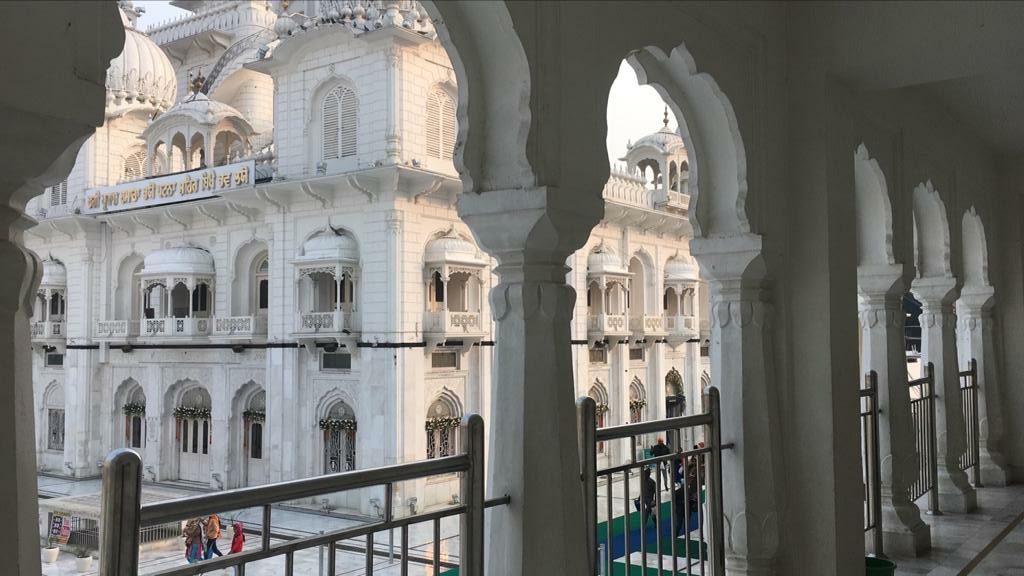
Whenever one thinks of a polity, a white-pillared Senate building comes to mind with high ceilings and long, monotonous rows aligned in a Parliamentary fashion; or we may also think of a government building with endless cubicles and offices protected by heavily-armed guards in uniforms. But there exist places in our diverse motherland, which defy all pre-existing notions of polity, community, and religion. In Patna, the capital city of Bihar lies one of the most important shrines for the Sikh Community – the Takht Sri Patna Sahib Gurudwara.
In a statistic published by the Times of India, the Gurudwara Patna Sahib, one of the 5 takhts, witnessed 3.35 crore tourists in 2017 alone, including 10.82 lakh foreigners. Panj Takht(s) take religious, social and political decisions as required by the Sikh community. One would assume the location of the Takht would have also affected the settlement of the Sikh population. The assumption could not have been further from the truth. The Sikh population in Patna forms 0.08% of the total population which averages out to be less than five thousand. However, even for this small group of believers of Sikhism, the Patna Sahib offers an alternative polity, taking care of their social and economic needs.
To begin with, despite being a minuscule silent minority of Bihar, the Sikhs here never faced oppression and subjugation because the Gurudwara’s stronghold made the indigent less vulnerable in society. The Gurudwara adopts and employs the destitute. During the research for this article, a majority of the respondents admitted to living and studying in the Patna Sahib. The Langar facility of the shrine took care of their diet. The volunteers taught them languages such as Punjabi and Hindi as well as other subjects like Mathematics and Science.

The majority of the Sikh population in Patna live in and around the Patna Sahib and Gurudwara Bal Leela Maini Sangat, both situated in Patna city. Minority schools and colleges have come up in proximity to the Gurudwara and a community has been formed within the larger township. The only other major settlement is the Punjabi Colony of Chitkohra which is settled around the Chitkohra Gurudwara, and that too because the latter does not come under the administrative powers of the Takht.
The Gurudwara is not just a means of sustenance and livelihood, but also an important stepping stone for gaining administrative and social reform at the State Level. Officials at the Gurudwara have a say in changing the discourse of Sikh reforms under Chief Minister Nitish Kumar’s government. For any actual reform to take place such as choosing a Sikh representative in the State Minority Commission as well as conducting elections for internal affairs within the Patna Sahib, the Amritsar Takht wields a humongous amount of power. There is an interesting turn to the story, the Sikh representative seats in the State Minority Commissions have been unoccupied for so long that a large share of the population has forgotten that it existed in the first place! Besides the State Minority Commission, the Principal’s seat at the Sikh College and the fifteenth seat of the administrative body are also empty. The positions which did not have a Sikh criterion have been filled by representatives of other religions – mostly that of Hinduism.
In an extremely anti-minority political climate, it is intriguing to study how citizens have turned to alternative means of power. The Gurudwara in Patna becomes an all-embracing lord that solves problems relating to religion, social and political status, education and sustenance. Therefore, most people do not incline to approach the Central or State government as their predicaments are taken care of by the Gurudwara. The Sikh minority in Patna is one of the few minorities of India that have never “claimed” a minority status or any compensation for their community from the government. A reasonable explanation can allude to the nature of the Sikh qaum which upholds ideals of bravery and resilience. Begging or lobbying is a mandate prohibited by the very religion which protects them.
The Patna Sahib, then, not just becomes a symbol of Sikh representation in Patna, but also that of self-empowerment and encouragement. The Gurudwara extends its role as a shrine and goes on to become much more to the people who associate their lives with it.
Author: Mahima Mehra

